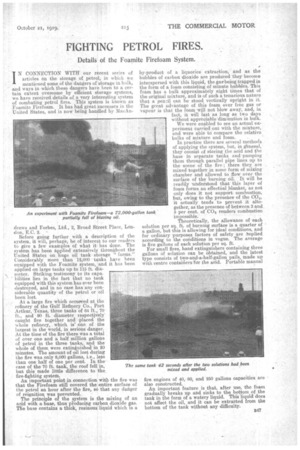FIGHTING PETROL FIRES.
Page 19

If you've noticed an error in this article please click here to report it so we can fix it.
Details of the Foamite Firefoam System.
IN CONNECTION WITH our recent series of articles on the storage of petrol, in which we mentioned some of the dangers of storage in bulk, and ways in which these dangers have been to a certain extent overcome by efficient storage systems, we have r eceived details of a very interesting system of combating petrol fires. This system is known as Toamite Firefoam. It has had great successes in the United States, and is now being handled by MacAn
drews and Forbes, Ltd., 2, Broad Street Place, London, E.C. 2.
Before going further with a description of the system, it will, perhaps, be of interest to our readers to give a few examples of what it has done. The system has been applied extensively throughout the United States on huge oil tank storage " farms." Considerably more than 12,000 tanks have been equipped with the Foarnite system, and it has been applied on large tanks up to 115 ft. dia
meter. Striking testimony to its capabilities lies in the fact that no tank equipped with this system has ever been destroyed, and in no case has any considerable quantity of the petrol or oil been lost.
At a large fire which occurred at the refinery of the Gulf Refinery Co., Port Arthur, Texas, three tanks of 64 ft., 70 ft., and 90 ft. diameter respectively" caught fire together and placed the whole refinery, which is one of the largest in the world, in serious danger. .At the time of the fire there was a total of over one and a half million gallons of petrol in the three tanks, and the whole of them were extinguishea in 20 ininutes. The 'amount of oil lost during the fire was only 8,000 gallons, i.e., less than one half of one per cent. In the case of the '70 ft. tank, the roof fell in, but this. made little difference to the fire-fighting system.
An important point in connection with the fire was that the Firefoam still covered the entire surface of the petrol an hour after the fire, so that any danger of reignition was prevented.
The principle of the system is the mixing of an acid with a base, thus producing carbon dioxide gas. The base contains a thick, resinous liquid which is a
by-product of a liquorice extraction, and as the bubbles of carbon dioxide are produced they become interspersed with this liquid, the gas being trapped in the form of a foam consisting of Minute bubbles. This foam has a bulk approximately eight times that of the original mixture, and is of such a tenacious nature that a pencil can be stood vertically upright in it. The great advantage of this foam over free gas or vapour is that the foam will not blow away, and, in fact, it will last as long as two days without apprecia.ble'dimmution in bulk.
We were enabled to see an actual eaperiment carried out with the mixture, and were able to compare the relative bulks of mixture and foam.
In practice there are several method's of applying the system' but, in gbrieval, they consist of storing the acid and the base in separate tanks and pumping them through parallel pipe lines up to the -scene of the fire ; there they are . mixed together in some form of mixing chamber and allowed to flow over the surface of the burning oil. It will be readily understood that this layer of foam forms an effectual blanket, as not only does it not support combustion, but, owing to the presence of the CO,„ it actually tends to prevent it altogether, as the presence of between 3 and 5 per cent. of CO2 renders combustion impossible.
Theoretically, the allowance of each solution per sq. ft. of burning surface is a quarter of a gallon, but this is allowing for ideal conditions, and for ordinary -purposes factors of safety are :implied according to the conditions in vogue. The average is five gallons of each solution per sq. ft. For small fires, hand extinguishers containing three gallons Of solution can be obtained, and the latest type consists of two-and-a-half-gallon pails, made up With centre containers for the acid. Portable manual
fire engines of 40,-80, and 250 gallons capacities are also constructed.
An important feature is that, after use, the foam gradually breaks up and sinks to the bottom of the tank in the form of a watery liquid. This liquid does not affect the oil, and it can be extracted from the bottom of the tank without any difficulty.
























